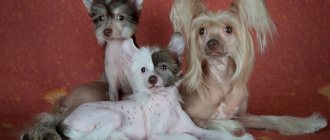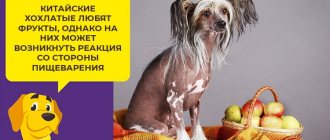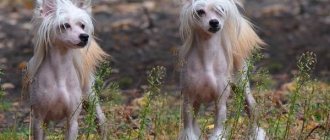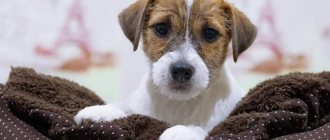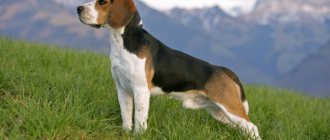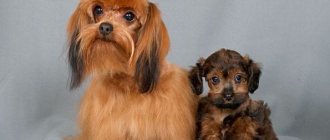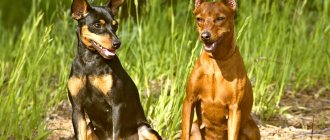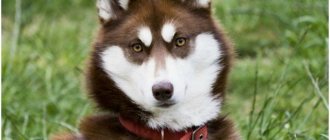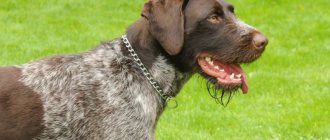Origin story
The history of the origin of the Chinese Crested is shrouded in myths and legends. It is not known for certain when the breed appeared in China. Some researchers believe that these dogs were kept in the emperor's palace more than 2,000 years ago, but this version has no convincing evidence.
The real homeland of the Chinese Crested is also unknown. Hairless dogs were common in hot climates. They lived in Africa, Mexico, Turkey, Malaysia and Peru. Some people associate the lack of fur with high temperature, others with a gene mutation.
The version of the Mexican origin of the breed has the most supporters. The Chinese Crested probably came to China on Latin American ships. Sholos, hairless Mexican dogs, are considered her possible ancestors. Corydalis were brought to Europe in the 19th century. The British were actively involved in their breeding and first showed the dogs at the New York exhibition in 1885. They worked on the standard for many years, and in 1973 the breed was recognized by the FCI.
There are many myths that explain the dog's unusual appearance. The ancients believed that the corydalis used to have a warm fur coat, which it shed to warm the baby who was freezing in the forest. The gods appreciated the animal’s act and ordered the parents to protect the rescue dog.
Interesting facts about the breed
There are many legends and myths associated with hairless dogs. It is believed that hairless pets first appeared in Africa, and then were brought to Mexico, China, Turkey and Argentina, or appeared there independently. Despite their unusual appearance, these breeds are the most ancient. It is also interesting that such dogs have come down to us almost in their original form, preserving the appearance of their ancestors.
Hairless dogs were considered sacred animals, personifying all the best qualities of loyalty and affection for humans. The legend of the appearance of these dogs says that one day a boy was lost in the forest, and to warm him up, the dog covered him with its fur. The child's parents were so amazed by this event that they took the dog with them. Since then, in memory of that day, naked dogs have accompanied people and served them faithfully. And sometimes among the naked puppies one with long soft fur appears, so that in case of trouble, it will come to the rescue again.
There is evidence that the Toltecs not only revered the dog as a symbol of fidelity, but also considered it a guide to the afterlife. After burial, the pet spoke at the afterlife court, tipping the scales of justice in favor of the owner.
Many pre-Columbian stories also mention a small hairless dog with a funny crest. She accompanies people on long journeys, as a result of which she ends up in Asia.
Description of the breed
The Chinese Crested is a small, hairless dog with a distinctive hairstyle. Its skin has a velvety texture that suffers from exposure to the sun. There are two body types - deer and pony. Deer are distinguished by their fine bones and grace, and are prone to excessive nervousness. Ponies are more powerful and stocky, have a calm character.
The breed is divided into two varieties according to the degree of hairiness:
- naked;
- downy
Breed standard:
- The dog grows up to 33 cm and weighs up to 5 kg.
- Head with a rounded, elongated skull. Overall, it looks very elegant. The muzzle is flattened, tapering towards the nose. Smooth transition from forehead to muzzle. The lips fit tightly to the teeth.
- The nose can be any color.
- The crest begins at the transition point from the forehead to the muzzle and goes down to the base of the neck. Can be flowing or short.
- The eyes are medium in size and widely spaced. The protein is almost impossible to see. The iris is dark brown, almost black, making the eyes resemble olives.
- The ears are erect, large, low-set. They can be completely naked or decorated with fringe. The downy variety has drooping ears. For both species, ears set on semi-cartilage are unacceptable.
- The jaws are strong and well developed. Scissor bite. Let's assume incomplete dentition, poorly developed teeth, small canines. These breed features are characteristic of all hairless dogs.
- The neck is dry and long, without dewlap. Has an elegant curve.
- The limbs are long and graceful. Hare-shaped paws.
- The tail is high-set and gradually tapers to a tip decorated with a thick tassel.
The color has no restrictions: it can be spotted or solid. The standard allows any combination of colors. The most common is the bald spotted variety.
Chinese Cresteds are more likely than other breeds to win the “most terrible dog in the world” category.
Bald
The naked corydalis is the most numerous variety of the breed. Her head, tail and limbs are covered with straight, long hair. Villi, invisible to the eye, grow over the entire surface of the body. The highlight of this look is wool boots. Some dogs have islands of fur on their bodies. The pile is very soft and silky, has no undercoat. The skin is soft, velvety, and hot to the touch. Sensitive to sun exposure.
Both hairless and furry babies can be born in the same litter.
Downy
The Chinese Crested or Powder Powder is a less common variety. It is distinguished by long, thick hair with abundant undercoat. The undercoat is soft and fluffy, the guard hair is long and coarse. The shortest hair is in the muzzle area. Owners often trim it to give the dog a well-groomed appearance.
Puffballs have a friendly and affectionate disposition. They understand the owner’s mood well and will never impose themselves. Puffballs are similar to cats and are not prone to zoo aggression: they get along well with any animal.
Appearance and color
The Chinese Crested Powder Dog has a rather extraordinary appearance. These dogs, however, like many other favorites of this Chinese breed, are small in size. Their height varies from 28 to 33 cm. These sizes fit well into the standards. But the weight of these animals is not specified in any way by the standards and reaches up to 5 kg.
The appearance can be described as follows:
- the Chinese Crested Powderpuff is a rather thin dog;
- has long limbs;
- the tail is elongated, completely covered with hair;
- The body of this dog is not covered with hair;
- they have beautiful rectangular faces;
- almond-shaped eyes are mostly dark brown, almost black;
- The ears are large and always stand up (in some cases they can hang down).
Color
According to color, Chinese crested downy dogs are divided into two types: downy - Powderpuff, without hair - hairless.
These dogs are usually called hairless, although they have hair in some places. The head, for example, is completely covered with it. The tips of the paws are also covered with hair. It looks like they are wearing socks on their paws. The tail has already been mentioned. It, like the head, is also completely covered with fur.
The hairless crested dog's body is usually dark brown, but can be pale pink with black spots.
Powderpuff is a crested dog with fur. There are no bare areas on the body. It is completely covered with long, coarse hair. The undercoat is soft and silky. Such pets look quite neat and well-groomed, if, of course, you take care of them.
The Chinese Crested Powder Dog can come in several colors, from pure white to white and dark gray.
Character
The Chinese Crested is a decorative, people-oriented breed. She needs constant communication and cannot stand separation. Left in an empty apartment, the dog will begin to howl and whine.
These kids love outdoor games. Their cheerful, active nature makes them amazing companions. To please a person, corydalis will learn funny tricks and try to remember commands. This breed is characterized by some shyness. A puppy that has moved to a new home will be timid and will not play with toys.
Corydalis are not classified as barnacles. Prolonged barking means that the dog is nervous about something or is lacking communication.
The Chinese are attached to every member of the family. An adult corydalis will not be able to love its new owners. When purchasing a dog, a person takes on great responsibility. He will become her raison d'être. Females are known for their strongest maternal instincts. They even take care of adult puppies.
But corydalis do not always get along with human “cubs”. They prefer to communicate with teenagers. Small children frighten them with loud noises, which can cause the dog to become nervous and hysterical. In addition, kids can accidentally injure the dog. Its long, graceful paws are especially fragile. The Chinese are friendly towards cats and other pets. The main thing is not to have favorites: corydalis are very jealous.
Care and maintenance
This breed is intended for indoor keeping. A soft house or lounger is suitable as a sleeping place. It is placed away from balcony doors and dark corners. Dogs can be trained to use the outdoor toilet or litter box. You should not turn your corydalis into a lap dog. Lack of activity can lead to obesity. Pets also need to be provided with toys, otherwise they will take up the furniture.
The hairless variety has sensitive skin. It should be regularly inspected for abrasions, cracks and irritation. If the owner notices that the skin has become dry, he should lubricate it with moisturizer.
During the summer months, the skin of corydalis is lubricated with sunscreen.
During the first walks, use a collar made of leather or with a silk base. It is better to show show dogs in the show ring. To prevent your pet from catching a cold, he will need clothes. It must correspond to weather conditions, protect from moisture and cold. In autumn, a sweater, raincoat and overalls are a must. In winter, you need insulated overalls. In summer, light dresses and T-shirts are acceptable.
In the first months of life, the puppy grows actively, so the wardrobe is updated as needed. Making your own clothes is a great way to save money. You can find many knitting patterns and patterns on the Internet. The main thing is to use natural materials. The yarn should not be prickly or emit a specific odor.
Corydalis have bad teeth, so you need to take care of your oral cavity from the first months of life. Teeth are brushed daily or every few days. Dog toothpaste is suitable for this. Ears are checked regularly and cleaned as needed. The procedure is carried out using a cotton pad soaked in warm water. The eyes are cleaned of secretions with a cotton swab dipped in warm water or chamomile decoction. Movements should be directed towards the corner of the eyes. Nails are trimmed 2-4 times a month.
Regular vaccination is of great importance. The first vaccination for a puppy is given at the age of 8 weeks. After 2-3 weeks, re-vaccination is carried out. The next vaccination is at the age of 1 year. After this, vaccination is carried out annually.
10-14 days before vaccination, the worms are treated.
Some Cresteds have weak ear cartilage. To place the ears, they need to be glued with adhesive tape. Cotton swabs act as supporting structures.
Grooming
Hairless Chinese Crested needs face trimming and body hair removal. The muzzle is carefully trimmed with a clipper to avoid irritation, and the skin is treated with cosmetic oil. Body hair can be epilated with a cream or device. Excess hair on the back, hips, and shoulders should be trimmed regularly.
A dog should never be shaved with a human razor.
Naked corydalis are bathed weekly. The body is wiped with a soft washcloth, the mane is washed with a special shampoo and conditioner. After this, the dog is wiped dry. The skin is moisturized with cosmetic oil.
Haircut of the corydalis can be hygienic or model. Not every owner can cut a dog's hair at home, so it is better to contact a professional groomer. Grooming includes hairdressing services and a range of hygiene procedures. Some dogs are very afraid to have their nails trimmed and will not allow their ears to be trimmed. In this case, it is better to contact a specialist.
A haircut at home includes trimming the body with a clipper and shaping the mane. Some owners prefer to shave the hair on the ears. The hair above the eyes can only be cut with scissors. The paws are cut in the manner of spats, which start 2-5 cm above the hock joint.
The coated Chinese Crested requires regular brushing. For this purpose a furminator is used. Dogs are bathed 2 times a week using special cosmetics. Puff puffers do not shed seasonally, so the owner must comb the animal himself and, if necessary, remove tangles. Haircut can be in different styles. The main thing is to design the face properly. Some owners dye their dogs extreme shades and give them intricate hairstyles.
Feeding
Chinese Crested cats can be fed both natural dishes and high-quality dry food. The main thing is to stick to the chosen type of nutrition throughout your life.
Natural nutrition should be based on the following products:
- lean meat: beef, veal and horse meat;
- lean sea fish;
- well-cooked beef offal;
- low-fat kefir and cottage cheese;
- rice, buckwheat;
- boiled egg or raw yolk (1-2 per week);
- vegetables: carrots, zucchini, cucumbers;
- seasonal fruits (excluding exotic ones).
Adult dogs are fed 2 times a day.
Natural feeding should be accompanied by courses of mineral supplements.
List of prohibited products:
- chicken, pork;
- chicken and pork by-products;
- corn, wheat;
- River fish;
- bones;
- legumes;
- potato;
- soy;
- grapes and raisins;
- fatty, salty, smoked, spicy, sweet;
- fresh bread and products made from yeast flour.
Chinese Cresteds are prone to allergic reactions, so many breeders recommend feeding them super-premium hypoallergenic dry food. They are made from whole meat and natural ingredients. Premium and economy class feeds are of lower quality and are made from by-products. Their whole meat content is usually low. Cheap drying is especially dangerous: it contains waste from slaughterhouses.
Quality feeds include:
- Naw;
- Go!;
- Applews;
- Golden Eagle;
- Akana;
- Orijen;
- Grandorf;
- Belcando.
The listed foods belong to the holistic class, that is, they are suitable for sensitive skin. Drying does not require taking additional vitamins: all the necessary substances are included. The recommended daily serving size is indicated on the packaging.
When feeding dry food, the dog must have constant access to water.
What to feed a puppy
The menu of 2-month-old babies can include a variety of complementary foods: dry food for puppies or natural dishes. If the owner decides to raise the baby on homemade food, he can introduce boiled veal or beef, low-fat kefir and cottage cheese, a small amount of ocean fish, semi-liquid rice or buckwheat porridge, and fresh vegetables into the diet of a 2-month-old puppy.
At 3 months, add raw beef, boiled egg or raw yolk (1-2 times a week), new varieties of sea fish. For a 4-month-old puppy, porridge is boiled in meat broth and various vegetables are added to it. At the same time, seasonal fruits are introduced. Milk is excluded from the diet. Older puppies can be fed like adult dogs. At 2 months, babies are fed 4-5 times a day. One serving: 20-30 g. At 4 months - 3 times. At 6-8 months - 2. We recommend serving size - 60 g.
Puppies
By choosing a Chinese Crested as a companion dog, you “doom” yourself to constant positivity. She is very loving, attentive and affectionate. For her, the owner is the center of the Universe, so the following point is important: if you are constantly at work and cannot pay enough attention to your pet, then the “Chinese” is not for you. She will suffer greatly from loneliness.
Chinese Crested puppies reach new owners at approximately 1.5 -2 months. When examining them, choose the most energetic and cheerful one. If you do not want to spend a lot of time on grooming, then purchase hairless representatives of the breed.
How to prepare your apartment for the arrival of a curious and super-active pet?
- Place indoor plants, especially cactus and ivy, out of the puppy's reach. If your dog eats them, he will be seriously poisoned.
- Shoes are dogs' favorite items. It is better to keep outdoor boots and shoes away, because they are sources of viruses coming from the street. For an unvaccinated pet, viruses and bacteria will become a threat.
- Buy toys for your pet in advance, preferably not small and rubber ones so that the dog cannot bite or swallow them.
In the Chinese Crested breed, puppies learn the rules of behavior in the first 1-4 months. The beginning of education should occur precisely during this period. Puppies should not be allowed to do things that would not be prohibited for an adult dog, for example, biting the owner even during play, taking food from the table, or sleeping on the owner’s bed.
Due to the lack of fur, it can sometimes be problematic to take a Chinese dog out for a walk in severe frosts. Therefore, it is important to teach her to go to the toilet using a tray or diaper. Being clean dogs, Chinese Cresteds quickly learn to go to the toilet in a certain place.
Proper and hypoallergenic nutrition is another important requirement in keeping a puppy. Dogs often develop allergies, which manifest themselves in the form of redness and pustules on the skin. Having chosen the type of food: natural or dry ready-made, it is important not to allow them to be mixed.
Training and education
After the puppy finds itself in a new family, it is taught the rules of behavior. The baby is prohibited from begging for treats, jumping on the bed, or pulling on the leash. It is very important to accustom the puppy to the place, feeding schedule and toilet. The dog must immediately understand who is boss in the house, otherwise further training will be pointless.
The puppy needs to be trained using approval and encouragement. Screaming and physical violence are completely unacceptable.
The Chinese perceive training as an exciting game. The training of commands begins with the standard ones: come to me, sit and you can’t. The treat should be given only after the task has been completed. The command must be given in one form. If the puppy enjoys training, he can be taught circus tricks. Corydalis are agile and jumping dogs. At the age of 4-5 months, you can move on to complex commands or sign up for classes with an instructor.
Training
Training a “Chinese girl” is a pleasure. Like many other representatives of decorative breeds, she listens carefully to her owner and picks up commands on the fly. Dog handlers note that crested animals are extremely inquisitive. And it is precisely around this character trait that training must be built so that it produces quick and high-quality results.
- “No” to the whip. Yelling and physical abuse of a dog is extremely unacceptable. Due to its miniature size, the Chinese Crested is prone to acutely perceive rudeness from someone whom it loves and trusts so much. These dogs instantly grasp the slightest changes in the owner’s voice and react painfully to them. When starting training, you need to give yourself the attitude: calm and only calm.
- “Yes” to gingerbread. Experts recommend socializing the animal starting from the age of three months. The crested baby will be distracted by objects and phenomena that the street is full of. Use treats to attract your baby's attention. Better special ones, not sausages or sweets. The latter will be bad for his liver.
Diseases and life expectancy
The Chinese are considered a fairly healthy breed, but are not free from breed diseases. The most common ones include:
- keratoconjunctivitis;
- Perthes disease;
- dislocation of the kneecap;
- allergy;
- acne;
- sunburn;
- oral diseases;
- complications during childbirth.
Allergies in Chinese crested cats are treated with the help of veterinary lines of high-quality food, drugs Emicidin, Suprastin, Tavegil, Diazolin. Only a veterinarian can prescribe the correct treatment, but experienced breeders recommend having Emicidin in your home medicine cabinet.
Many mini-dog asters tremble, and the Corydalis is no exception. Most often, the dog trembles from cold, excitement and stress. Medical causes include hypoglycemia, hormonal disorders, poisoning and allergies.
Average life expectancy: 12-18 years.
Crossbreed
The Chinese Crested Dog has an exotic appearance, which provokes the appearance of mixed breeds. Accidental matings are also common.
Common crossbreeds include:
- Pug and Chinese Crested mix. This cross is called Khokhlomops. She looks like a hairless pug with high-set ears and tufts of hair on her face. The skin appears rough, reminiscent of a hippopotamus.
- Mixed Chihuahua and Chinese Crested. This mix looks like a hairless Chihuahua, with a deformed muzzle and a crest on the top of its head. It was these mestizos that more than once received the title of the ugliest dog in the world.
- Spitz and Chinese Crested mix. The rarest cross. Spitz and Hairless Crested mixes are practically never found, and their cross with Powder Puffs looks quite cute.
Unfortunately, most mestizos suffer from genetic abnormalities and have a short life expectancy.
Price of Chinese Crested
The Chinese Crested is an expensive dog breed, and it also requires proper care and attention. This must be taken into account when purchasing. The price for a Chinese Crested dog puppy depends on the type, because the dog can be completely covered with hair or have bare skin.
- A downy crested dog with a documented pedigree, good health and excellent upbringing will cost from 12 to 25 thousand rubles.
- The naked type of the breed, more unique and valuable, will require from 25 to 50 thousand rubles.
Breeding this breed requires skill, patience and excellent knowledge, which is why the result is valued so highly. What can affect the cost?
- The dog has color defects and differs in some characteristic features of the breed.
- There are health defects that do not threaten the life of the animal, but reduce the value of the breed.
- The owner urgently needs to place puppies or an adult dog.
- Girls of this breed, and not only this one, are usually cheaper.
Even if it is possible to buy a Chinese Crested dog inexpensively, it is worth remembering that this is the acquisition of a living creature and will need to be taken care of constantly.
How to choose a puppy
The best place to buy a puppy is a specialized nursery. Conscientious breeders do not hide important facts and warn about the difficulties of keeping them. Purebred babies are physically healthy and have social skills.
Before buying a puppy, you need to visit several different nurseries, read reviews, and perhaps go to an exhibition. Choosing a pet is a very important decision. Communication with him should be a joy. You should not take weak and sick babies: the early loss of a pet will be a real tragedy.
At the screenings, pay attention to the following:
- organization of living space;
- appearance and health status of parents;
- activity of puppies (lethargy and hyperactivity - deviation from the norm);
- condition of fur, skin, ears, eyes, gait;
- presence/absence of discharge from the nose and eyes;
- presence/absence of mechanical damage;
- reaction to strangers;
- attitude towards brothers and sisters;
- availability of declared documents and vaccination marks.
It is best to take a specialist or an experienced owner to meet the puppies. They will notice even minor flaws.
Where to buy and price
The Chinese Crested is not the rarest dog breed, but most of the officially registered kennels are located in cities with a population of over a million. Therefore, transportation costs are often added to the cost of the puppy.
List of nurseries:
- Imperial status (Moscow, Yaroslavl);
- Luniks Style (St. Petersburg);
- Sapphire from Tsarskoye Selo (St. Petersburg);
- Alpha Adelante (Novosibirsk);
- May Lucky Love (Murmansk);
- Chach Beauty (Novosibirsk).
On average, puppies cost 20,000-50,000 rubles. Nicknames for boys: Icarus, Spartak, Umka, Twig, Dixie, Bart, Rudi, Charlie. Nicknames for girls: Kaya, Bonya, Sophie, Iva, Peggy, Florence, Chloe, Holly, Sherry.
Photo
You have become acquainted with the Chinese Crested breed; a photo of this gentle pet is presented above. An aristocrat and a charmer, she can become a loyal friend and an excellent companion.
Interesting facts about the breed
Chinese Cresteds are very jumpy and resemble cats in this way. In terms of their ability to stand on their hind legs for a long time, only poodles are better than them.
There are many legends about Chinese Cresteds. One of them connects a dog of this breed and the Buddha himself. According to legend, Chinese women had mystical powers. They accompanied the Buddha in the guise of a hairless dog, and when danger threatened, it shed the hair from its entire body, leaving a mane on its head, and turned into a fearless lion.
In modern times, Chinese Cresteds are not only companions. In eastern countries, downy Chinese women live at temples, catch rats and, with their ringing barks, warn of the approach of guests.
In Russia, the breed gained popularity only at the beginning of the 20th century thanks to glamorous beauties who began to carry decorative dogs with them. Currently, there is a Club of Chinese Crested Fans in the country and more than 600 dogs are already registered.
Pros and cons of the breed
| + | — |
| Suitable for apartment living | Not suitable for families with small children |
| A wonderful companion dog | Difficulty tolerating separation from owner |
| Gets along well with cats and dogs of medium breeds | Tendency to genetic abnormalities |
| Suitable for active owners | Not suitable for the role of watchman or security guard |
| Has training abilities | Wool requires careful care |
| Long life expectancy | The naked variety is prone to sunburn |
| No seasonal shedding |
The Chinese Crested dog has an exotic appearance and a friendly character. She will be a wonderful companion for those who are ready to devote all their time to her. This dog adores its owner and will do anything to please him.
Life expectancy of a Chinese Crested Dog and possible diseases
The average lifespan of Chinese Cresteds is ten years . If all the rules of care are followed and a properly selected diet, dogs of this breed remain healthy for a long time and can live 15–18 years .
However, the breed has some genetic diseases. First of all, these are various allergic reactions. When giving your puppy new foods or medications, you must carefully monitor his condition.
Important! Intolerance to a particular product manifests itself in a dog with a rash, redness on the skin, and sometimes swelling develops.
This breed often has an incomplete set of teeth from birth and is prone to losing them.
Therefore, it is important to carefully monitor the condition of your pet’s teeth to prevent the development of tartar and other diseases.
A thoughtful diet will also help avoid weight problems. Dogs of this breed are often obese. This disease can be caused by overfeeding or an incorrectly selected diet.
Chinese Crested cats often suffer from dry eye syndrome, insufficient production of tear fluid. It is necessary to monitor the dog's eye health , since ignoring this problem will lead to complete loss of vision. A veterinarian or an experienced dog handler will tell you what means to combat this problem.
Please note that due to their small size and skeletal structure, Chinese Cresteds are quite fragile and can easily damage joints and bones. Even jumping from a chair can cause a dislocation or fracture .
The Chinese Crested Dog is a great choice! These dogs know how to cheer up, are extremely sensitive and responsive. They love attention very much, but if you are not interested in them, they will calmly go about their business. Such a dog will become a faithful friend , a cure for depression and will brighten your life.
